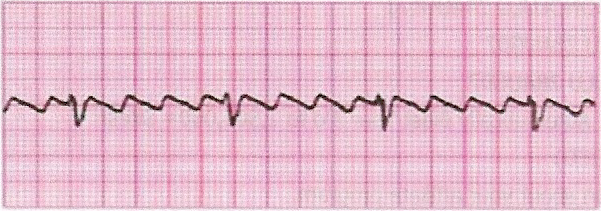
Atrial flutter can present much like atrial fibrillation; however the EKG findings for this disorder are much different.
Instead of having an irregularly irregular set of complexes, with no discernable P-wave activity, you will likely see a characteristic “saw-tooth” appearance of the QRS complexes. (5,6)
Another common presenting sign of atrial flutter is hypotension associated with palpitations. (5)
“A flutter” is a rapid tachycardia of ectopic atrial origin, with a rate typically between 250 and 350 beats per minute (or 150 beats per minute if it has 2:1 conduction, common). This is from only one ectopic pacemaker, which overtakes the natural pacemaker of the heart, the SA node. Typically, it takes many flutter complexes to produce a QRS (ventricular depolarization) complex. (6)
Many of the same causes exist for atrial fibrillation and atrial flutter. However, atrial flutter is more commonly associated with atrial septal defects, past medical histories of atrial operations, and with chronic obstructive pulmonary disease.
Drugs and medicines can also be a transient cause of atrial flutter.
Do you know that 90% of the stroke could have been prevented?
Smaller than a credit card, Kardia Mobile allows you to capture single-lead EKGs anywhere, anytime. In 30 seconds, it records a medical-grade EKG, which can be relayed to a doctor for analysis and diagnosis. Kardia Mobile easily attaches to most smartphones making it convenient to always have with you. Learn more about it.
